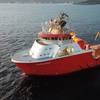With implied volatility in the Capesize sector being historically higher than that of the Panamax, this note observes and highlights their behavioral patterns (via the spread) after an expiry, says Freight Investor Services.
Current Capesize Q4 implied volatility is at 103.7%. This is nearly twice that of the Panamax Q4 implied volatility which is at 53%.
The graph illustrates the implied volatility differential between the Capesize 2 quarters forward, and the Panamax 2 quarters forward. Therefore the current spread in play will be on the Q4 expiry.
The spread has a tendency to widen atier the previous quarter expiry (rollover). Since January 2014 we have seen a positive return on 90% of the rollovers. The buyer of the spread benefits from a long Vega position, whilst having a reduced Theta position (about 1/3 less) due to the Panamax short.
The cyclical – and logical – nature of the spread is to widen after the rollover. This, in conjunction with the volatility band measurement, which are on their historical lows would suggest that the statistical likelihood is that we should see a continuaton of the current trend, and a widening of the spread.
For those wishing to increase exposure in the spread by reducing their Theta further, there is the option for a ratio trade, by selling some more of the Panamax options.
The downside of this is that you would be dealing with a negative Vega position (negative Gamma), meaning the spread would need to widen considerably.












